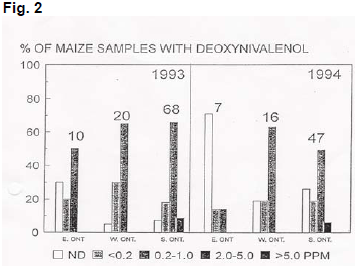



Fusarium Ear Rot in Corn and the Occurrence of Associated Mycotoxins
A report of a series of experiments and surveys into the possibilities of breeding corn varieties resistant to Fusarium fungus, and to develop a model to predict the level of mycotoxins in corn. Published as 15 from the Canadian Poultry Industry Council.The Poultry Industry Centre provided financial support to a study by Dr A. Schaafsma of Ridgetown College of Agricultural Technology to screen common corn hybrids for resistance to Fusarium graminearum.
The Study
This was part of a 4-year study undertaken to determine whether corn hybrids could be reliably screened for Fusarium graminearum. While the study has been going on for 4 years, only the 1994 study at Ridgetown, with 36 hybrids that were common to all 4 years are reported.
Inoculation
10 primary ears were inoculated per plot with 2 different methods of inoculation
- Silk channel method; where spore suspensions are injected into the silk channel without injuring cob or kernels
- Wounding; to simulate bird damage. This was accomplished by a “pin block” where a block with 25 small brass pins are pushed into the side of the cob so that the husk in penetrated.
The wounded area was then flooded with a Fusarium spore suspension. Plots were harvested when it was estimated that the grain contained 20% moisture or less.
Mould Severity Rationing
Cobs were rated for severity of mould varying from 1, (nil) to 7 (76 to 100% mould covered). A comparison of mould severity of several hybrids at Ridgetown in 1994 are shown for the two inoculation methods (Table 1).

Results
Within the group of 36 hybrids, maturity ranged from 2572-2878 CHU. No effect of hybrid maturity on mould severity was noted.
There were no hybrid X inoculation method interactions.
Highlights from the Research and Surveys
- a formal screening program has been developed to test for resistance to Fusarium in corn hybrids
- a formal yearly survey was initiated to determine relative risk of mycotoxin contamination by regions
- a model is being developed, based on survey data obtained, with the hope of being able to predict mycotoxin severity
Of interest is some of the data generated during the 1993 and 1994 surveys.
 |
 |
 |
 |
In Figure 1 the percent Fusarium infection of the corn samples surveyed in 1993 and 1994, for various regions in Ontario are shown. The most common isolate was F. subglutinans for both years, followed by F. graminearum, with F. moniliform being low for both years with the exception of Eastern Ontario in 1993. Other Fusarium were seen in very few samples.
From the above it follows that deoxynivalenol (DON), zearalenone (Zen) and fumonisins (FB) could be detected in samples. In Figure 2, the number of corn samples obtained and the percent and level of DON detected (not detected to > 5.0ppm) are shown. A few samples from southern Ontario had levels of DON ranging from 2-5 ppm, while in eastern Ontario, in 1994, most samples had non detectable levels of DON.
Similarly the number of samples tested, the percentage infection and the level of ZEN, are shown in Figure 3. Zen was not a serious problem in Ontario in 1993, 1994. Figure 4 shows similar data for FB infection. FB was found in very few samples. It is known that FB favors hot dry conditions. Eastern Ontario had a drought in 1993 and this is probably the reason for the higher levels see that year.
While mycotoxins are not a serious problem for poultry in Ontario, it is important that the industry keep abreast of the incidence and severity of these toxins as some can cause, and have caused, serious problems in certain flocks.








